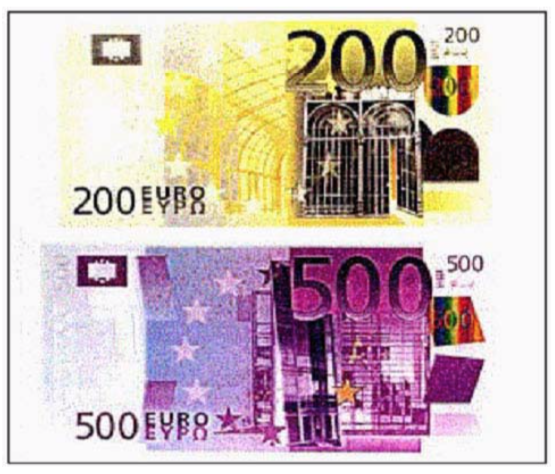The new Euro: A counterfeiter’s dream
Currently, the most counterfeited bill is the US $100. This is because it is a world-wide, easily recognized, standard of value. This is also why the US stopped producing the larger denominations such as the $500 and $1,000 bills. These were serious targets for counterfeiters and they allowed, according to US drug policy wonks, too much of a store of value, making it too easy for large sums of money to be moved undetected. Many nations have developed a similar strategy of printing lower denomination currency to reduce the likelihood of counterfeiting. In effect, they try to ensure that the cost of counterfeiting is higher than the cost of the real thing.
The new Euro’s larger denominations of €200 and €500 shown below are a temptingly greater store of value than the US $100. Assuming an exchange rate of $0.85 to €1, that makes the €200 worth $170 and the €500 worth $425.
 Some consider this policy decision to be a major blunder that invites counterfeiting. There is a fear that many will exchange marks and francs for counterfeit Euro’s while the population is still getting used to the look and feel of the currency. Others fear that counterfeit currency will be exchanged for real Euro’s. Others still have simply called the Belgian wonks fools and morons for issuing such high denomination notes that will obviously attract criminals.
Some consider this policy decision to be a major blunder that invites counterfeiting. There is a fear that many will exchange marks and francs for counterfeit Euro’s while the population is still getting used to the look and feel of the currency. Others fear that counterfeit currency will be exchanged for real Euro’s. Others still have simply called the Belgian wonks fools and morons for issuing such high denomination notes that will obviously attract criminals.
But why would the EU do something that is so obviously going to attract so much attention to their currency?
Let’s take a short lesson in central banking. Currency issued by a government is an interest-free loan from the user of the currency to the government or central bank. Thus, the world, while using dollars as a currency is giving the US Treasury an interest-free loan. The world’s largest amount of circulating currency is the US dollar, with 80% of all physical dollars ever issued circulating outside of the US.
Now, with a larger denomination note, more value can be stored in a given place; thus, people interested in using currency as a medium for international exchange will switch to the item with a higher (more concentrated) value. Thus more dollars will come out of circulation and will be replaced by euros. When people swap dollars for euros they will now give their interest free loan to the European Central Bank, not to the US Treasury. Some level of thought went into this.
The euro will slowly but surely replace the dollar as the unit for barter and exchange in the cash stashes and the illegal markets. Dollars will be sold and returned to the Treasury, and euros will be bought and flow into the market place. Economies don’t care who has the notes; all that counts is that they are out there.

